How to Build a Basic CRUD App with Angular?
In this guide, we will walk you through the process of constructing a basic CRUD (Create, Read, Update, Delete) application using Angular.
You’ll learn how to develop an application that efficiently manages data operations by leveraging Angular’s robust framework.
To start, you'll create and configure a new Back4app project titled Basic-CRUD-App-Angular, which will serve as the backbone of your backend data management.
Next, you'll design a scalable database model by outlining detailed collections and fields—either manually or with the assistance of the Back4app AI Agent. This step guarantees that your system is well-prepared to handle all CRUD functionalities.
After setting up your schema, you will explore the Back4app Admin App, an intuitive drag-and-drop interface, to easily manage your collections and records.
Finally, you will integrate your Angular frontend with Back4app using REST/GraphQL (or the Parse SDK, if preferred), while also implementing advanced security measures to safeguard your backend.
By the end of this tutorial, you will have built a production-ready Angular application featuring user authentication and comprehensive CRUD capabilities.
- Master how to construct CRUD applications that handle data efficiently with a reliable backend.
- Gain practical insights into creating a scalable data model and linking it to an Angular frontend.
- Learn how to utilize the Back4app Admin App’s user-friendly interface for effortless data management.
- Understand deployment strategies, including Docker containerization, to rapidly launch your Angular app.
Before you begin, please ensure you have the following:
- An Angular development environment. Install Angular CLI by running npm install -g @angular/cli and create a new project using ng new. Make sure Node.js (version 14 or above) is installed.
- A basic understanding of TypeScript, Angular, and REST APIs. For a refresher, visit the Angular documentation.
- Sign in to your Back4app account.
- Click the “New App” button from your dashboard.
- Enter the project name: Basic-CRUD-App-Angular and follow the setup prompts.
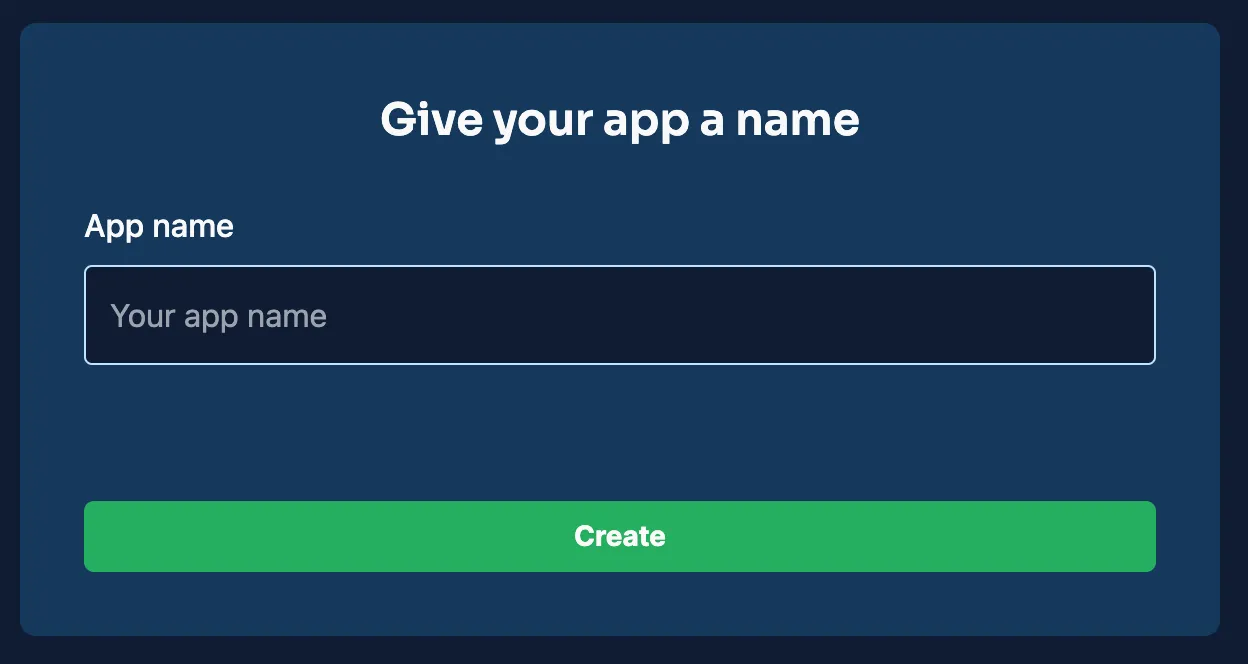
Once the project is created, it will appear on your Back4app dashboard, providing a strong foundation for your backend configuration.
For this CRUD application, you will define several collections. Below are examples of the collections and their fields that will form the basis of your database schema. These collections empower the application to perform essential CRUD operations.
This collection stores information for each item.
Field | Data Type | Details |
|---|---|---|
_id | ObjectId | Auto-generated unique identifier. |
title | String | The title of the item. |
description | String | A brief summary of the item. |
created_at | Date | Timestamp for when the item was added. |
updated_at | Date | Timestamp for the latest update. |
This collection maintains user credentials and authentication data.
Field | Data Type | Description |
|---|---|---|
_id | ObjectId | Auto-generated unique identifier. |
username | String | A unique identifier for the user. |
String | A distinct email address. | |
password_hash | String | Securely hashed password for authentication. |
created_at | Date | Timestamp indicating when the account was created. |
updated_at | Date | Timestamp of the most recent update. |
You can set up these collections manually in the Back4app dashboard by creating a new class for each and adding columns to define the fields.
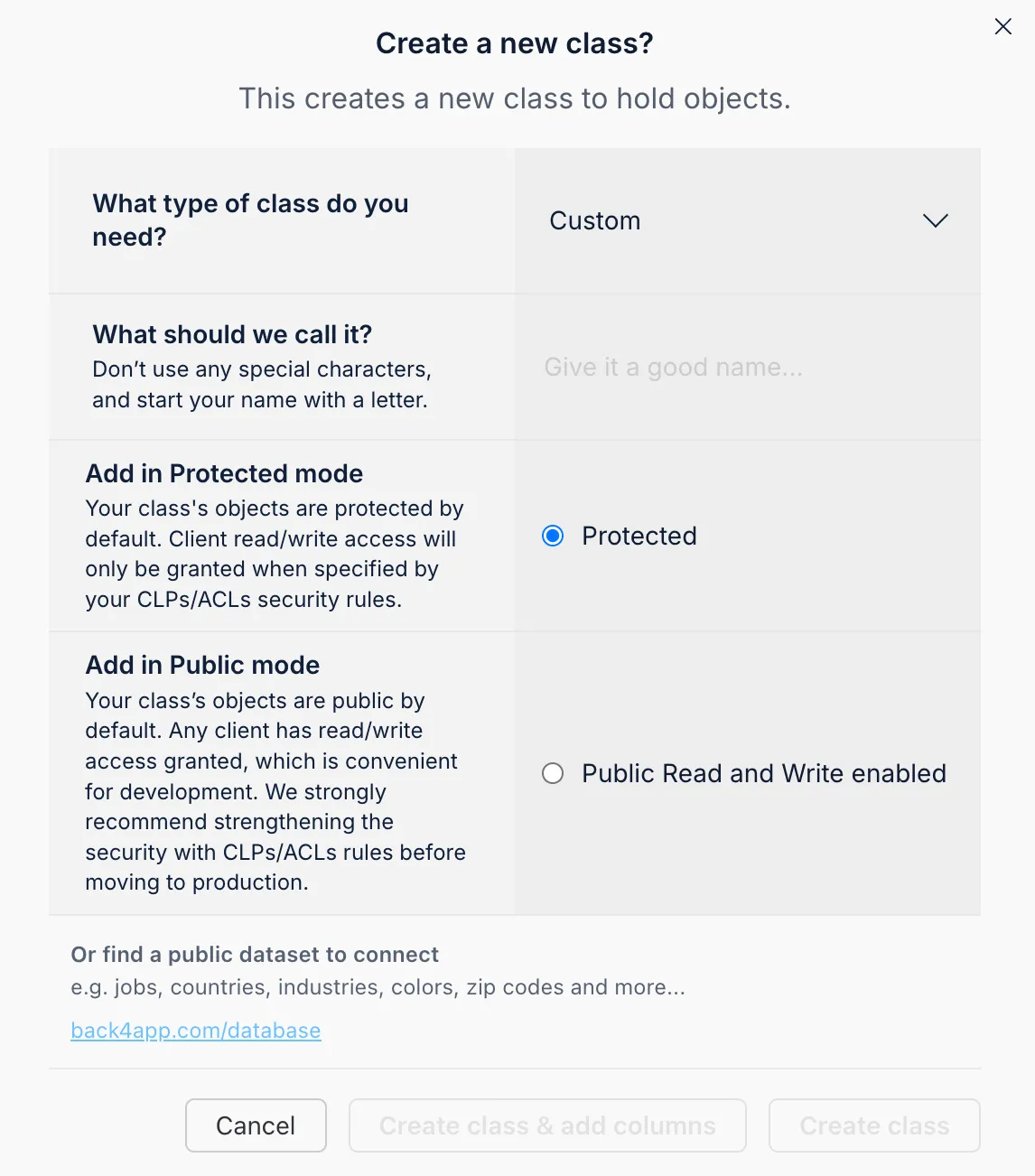
Add columns by choosing a data type, naming the field, setting a default value, and marking whether it is required.
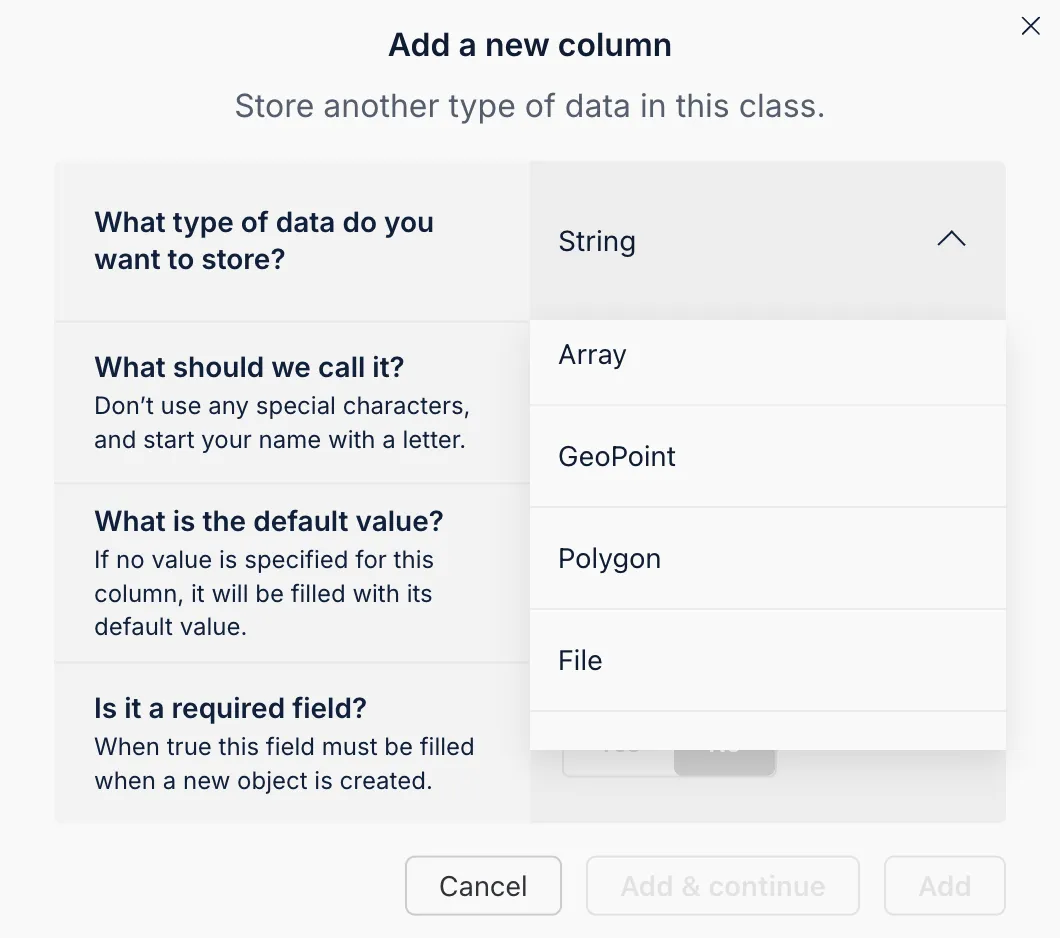
The Back4app AI Agent is a versatile tool available in your dashboard that allows you to automatically generate your database schema based on a descriptive prompt. This feature saves time and ensures that your backend is perfectly tailored for CRUD operations.
- Open the AI Agent: Log in to your Back4app dashboard and find the AI Agent option.
- Describe Your Schema: Input a detailed prompt outlining the collections and fields you need.
- Review and Confirm: After submission, review the generated schema and apply it to your project.
This AI-powered approach streamlines the process and ensures a consistent, optimized schema.
The Back4app Admin App provides a no-code, drag-and-drop interface that allows you to manage your backend data effortlessly.
With it, you can easily perform CRUD operations such as adding, viewing, modifying, and deleting records.
- Navigate to the “More” menu in your Back4app dashboard.
- Select “Admin App” and click “Enable Admin App.”
- Set Up Your Admin Credentials: Create your initial admin user, which will also configure roles (e.g., B4aAdminUser) and system collections.
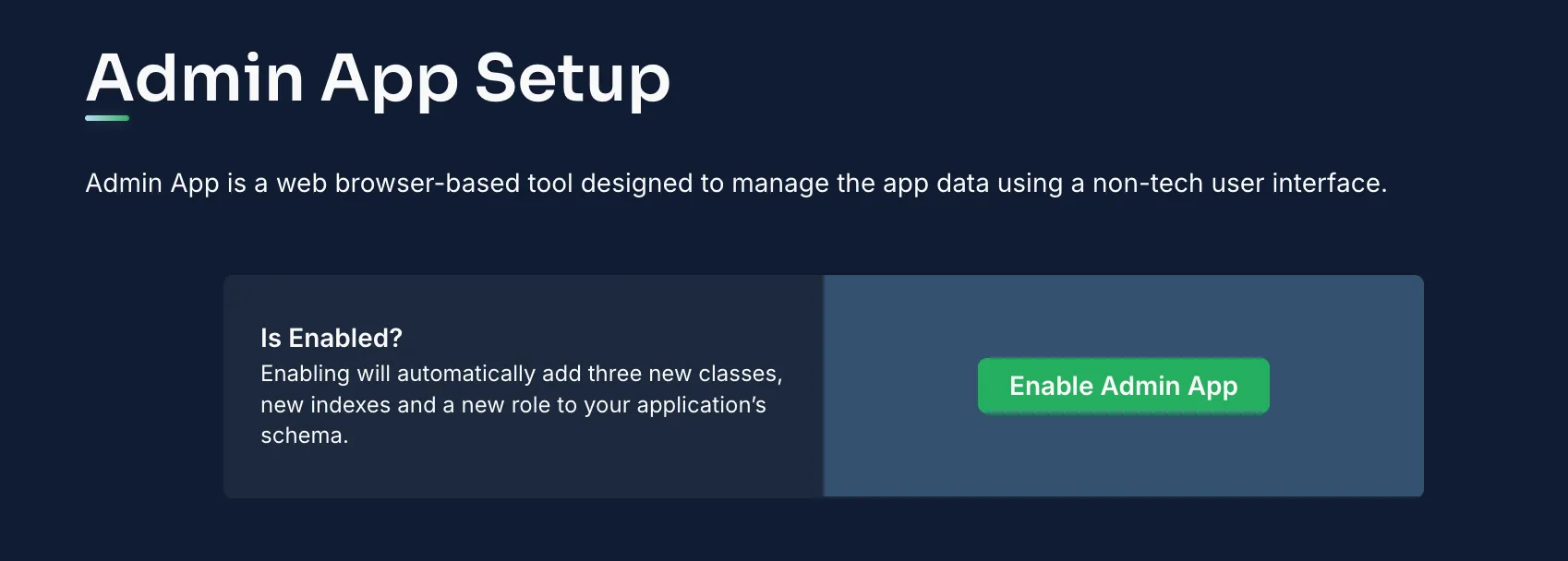
After activation, log into the Admin App to manage your collections and records.
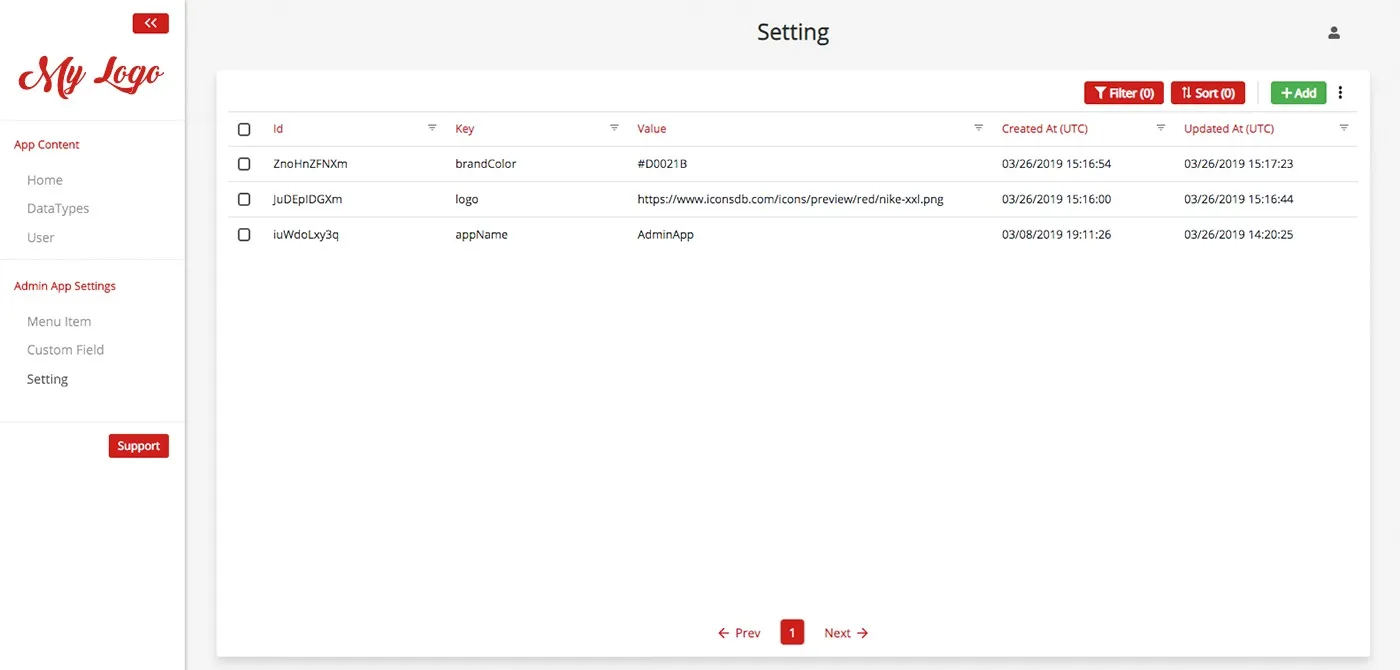
Within the Admin App, you can:
- Add New Records: Click “Add Record” in any collection (e.g., Items) to create new entries.
- View & Edit Records: Select a record to see its details or update its fields.
- Remove Records: Use the delete option to remove outdated records.
This intuitive interface greatly simplifies the management of your backend data.
Now that your backend is fully set up and managed through the Admin App, it’s time to link your Angular frontend to Back4app.
Install the Parse SDK:
Set Up Parse in Your Angular Project: Create a configuration file (e.g., src/app/parse-config.ts):
And in the HTML template (items-list.component.html):
If you prefer not to use the Parse SDK, you can execute CRUD operations via REST or GraphQL. For example, to fetch items using REST in Angular, create a service method like this:
You can integrate these API calls within your Angular components as needed.
Enhance your data security by assigning ACLs to your objects. For example, to create an item accessible only by its owner:
Within the Back4app dashboard, adjust the CLPs for each collection to set default access rules, ensuring that only authenticated or authorized users can access sensitive data.
Back4app utilizes Parse’s User class to manage authentication. In your Angular project, you can handle user registration and login as follows:
And the corresponding HTML template (auth.component.html):
A similar approach can be applied for user login and session management. For features such as social logins or password resets, adjust your settings in the Back4app dashboard.
Back4app’s Web Deployment feature enables you to host your Angular application by deploying code directly from a GitHub repository. In this section, you'll prepare your production build, commit your source code, and integrate your repository for deployment.
- Open your project directory in a terminal.
Run the production build command:
- Verify the Build: Ensure that the dist/ directory contains the index.html and all necessary assets.
Your repository should contain your entire Angular project. A typical file structure might look like:
Initialize a Git repository in your project folder if you haven’t already:
Add your project files:
Commit your changes:
- Create a GitHub repository: For instance, name it Basic-CRUD-App-Angular.
Push your code to GitHub:
- Access the Web Deployment feature: Log in to your Back4app dashboard, select your project (Basic-CRUD-App-Angular), and choose Web Deployment.
- Connect Your GitHub Account: Follow the prompts to integrate your GitHub account, allowing Back4app to access your repository.
- Select Your Repository and Branch: Choose your repository (e.g., Basic-CRUD-App-Angular) and the branch (e.g., main) that contains your code.
Provide the necessary configuration details:
- Build Command: If your repository lacks a pre-built dist/ folder, specify the build command (e.g., ng build --prod).
- Output Directory: Set the output directory to dist/your-project-name so Back4app knows where your static files are located.
- Environment Variables: Add any required environment variables (such as API keys) in the deployment configuration.
If you prefer a Docker-based deployment, include a Dockerfile in your repository. For example:
Include this Dockerfile in your repository, then select the Docker deployment option in Back4app’s Web Deployment settings.
- Click the Deploy Button: Once your deployment settings are configured, click Deploy.
- Monitor the Deployment Process: Back4app will pull your code, execute the build command if needed, and deploy your Angular app.
- Retrieve Your URL: After a successful deployment, Back4app will provide a URL where your application is live.
- Visit the Provided URL: Open the URL in your browser.
- Verify Functionality: Ensure that your Angular app loads properly, all routes function as expected, and assets are served correctly.
- Troubleshoot if Necessary: Use browser developer tools to identify and resolve any issues. Check Back4app’s deployment logs and your configuration if problems arise.
Congratulations! You have successfully built a basic CRUD application using Angular and Back4app.
You set up a project named Basic-CRUD-App-Angular, designed comprehensive database collections for Items and Users, and managed your data using the intuitive Admin App.
Additionally, you connected your Angular frontend to your backend and implemented robust security measures.
Next Steps:
- Enhance Your Frontend: Extend your Angular application with advanced features such as detailed item views, search functionality, and real-time updates.
- Expand Functionality: Consider integrating additional backend logic (like Cloud Functions) or implementing role-based access control.
- Explore Further Resources: Check out the Back4app documentation and other Angular resources to deepen your understanding.
With this guide, you are now equipped to build robust, scalable CRUD backends for your Angular applications using Back4app. Happy coding!
